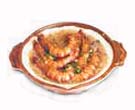|
|
Cuisine Glossary
| You have reached our International Cuisines and information on all aspects of a countries cuisine.
We will try to explain the culture, significant influences, climate, and other factors that have come together to create a distinct style. For example: Spanish, Mexican or Japanese. |
Philippine Cuisine
 |
Though the Philippines have an abundance of fresh seafood and a wide array of succulent tropical fruit, the daily food of the common people tends to be uninspiring. With a few exceptions, such as Bicol and the Muslim areas of the south, the seasoning isn't spicy. Native cooks have, however, devised some tasty recipes using ingredients such as coconut milk, jackfruit, garlic, and ginger. An unusual feature of Filipino cooking is the combination of major ingredients, e.g., chicken and shrimps, and pork and fish. Soups like sinigang and tinola are delicious, as is well-prepared lechon (roast suckling pig). An array of sweet morsels is made from glutinous rice, while halo-halo is a common dessert based on layers of preserved or sweetened fruit, gelatin, custard, and crushed ice. The special halo-halo is topped by a scoop of ice cream. So while Filipino dishes rarely reach sublime heights, it's possible to enjoy satisfying meals, accompanied by the excellent local beer, rum, or coffee.
Rice is the basis and bulk of a Filipino meal, at breakfast, lunch, and dinner. It's usually boiled to fluffiness, though the previous night's rice may be fried with garlic for breakfast. A normal meal in a poor family may consist of a mountain of rice soaked in meat sauce or salty fish or shrimp paste (bagoong), together with a tomato and piece of salt fish. Filipinos can accept the simplicity of such fare as long as the rice is good. Glutinous rice is the main ingredient of many kinds of cakes, puddings, and festive foods, prepared by mixing the rice with coconut milk, sugar, and flavoring. Rice preparation varies by region. Source: HungryMonster Writers |




